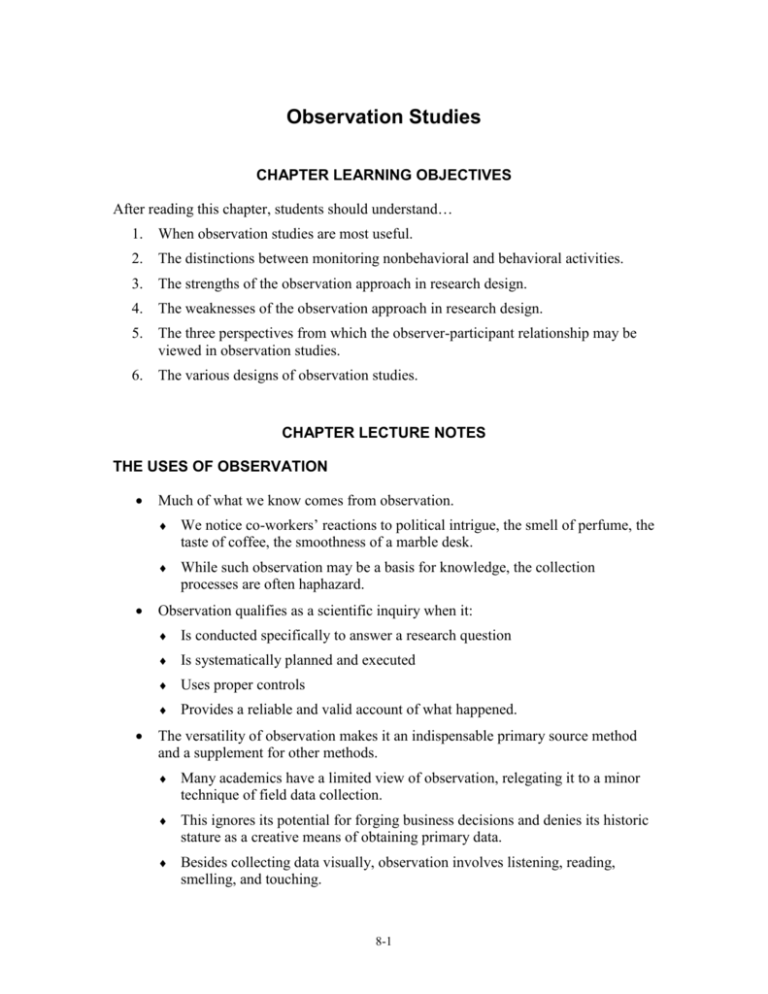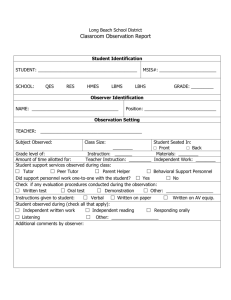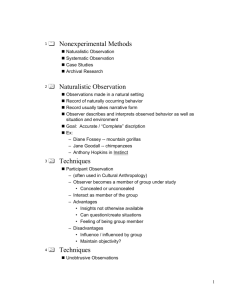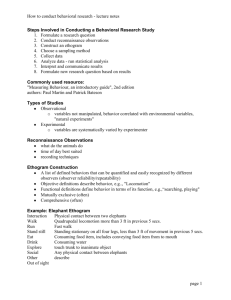Nonbehavioral Observation
advertisement

Observation Studies CHAPTER LEARNING OBJECTIVES After reading this chapter, students should understand… 1. When observation studies are most useful. 2. The distinctions between monitoring nonbehavioral and behavioral activities. 3. The strengths of the observation approach in research design. 4. The weaknesses of the observation approach in research design. 5. The three perspectives from which the observer-participant relationship may be viewed in observation studies. 6. The various designs of observation studies. CHAPTER LECTURE NOTES THE USES OF OBSERVATION Much of what we know comes from observation. We notice co-workers’ reactions to political intrigue, the smell of perfume, the taste of coffee, the smoothness of a marble desk. While such observation may be a basis for knowledge, the collection processes are often haphazard. Observation qualifies as a scientific inquiry when it: Is conducted specifically to answer a research question Is systematically planned and executed Uses proper controls Provides a reliable and valid account of what happened. The versatility of observation makes it an indispensable primary source method and a supplement for other methods. Many academics have a limited view of observation, relegating it to a minor technique of field data collection. This ignores its potential for forging business decisions and denies its historic stature as a creative means of obtaining primary data. Besides collecting data visually, observation involves listening, reading, smelling, and touching. 8-1 Behavioral scientists define observation in terms of animal or human behavior, but this too is limiting. As used in this text, observation includes the full range of monitoring behavioral and nonbehavioral activities and conditions, which, as shown in Exhibit 8-3, can be classified roughly as follows: Behavioral Observation: – Nonverbal analysis – Linguistic analysis – Extralinguistic analysis – Spatial analysis Nonbehavioral Observation – Record analysis – Physical condition analysis – Physical process analysis Nonbehavioral Observation A prevalent form of observation research is record analysis. This may involve historical or current records and public or private records. They may be written, printed, sound-recorded, photographed, or videotaped. Historical statistical data are often the only sources used for a study. Analysis of current financial records and economic data also provides a major data source for studies. Other examples of this type of observation are: The content analysis of competitive advertising and The analysis of personnel records. Physical condition analysis is typified by: Store audits of merchandise availability Studies of plant safety compliance Analysis of inventory conditions Analysis of financial statements Process or activity analysis includes: Time/motion studies Analysis of traffic flow Analysis of paper flows in an office Analysis of financial flow in the banking system 8-2 Behavioral Observation The observational study of persons can be classified into four major categories. Nonverbal behavior is the most prevalent of these and includes body movement, motor expressions, and even exchanged glances. – At the level of gross body movement, one might study how a salesperson travels a territory. – At a fine level, one can study the body movements of a worker assembling a product. – More abstractly, one can study body movement as an indicator of interest or boredom, anger or pleasure in a certain environment. Linguistic behavior is a second frequently used form of behavior observation. One simple type familiar to most students is the tally of “ahs” or other annoying sounds or words a professor makes or uses during a class. – More serious applications are the study of a sales presentation’s content or the study of what, how, and how much information is conveyed in a training situation. – A third form of linguistic behavior involves interaction processes that occur between two people or in small groups. Behavior also may be analyzed on an extralinguistic level. – – One author has suggested there are four dimensions of extralinguistic activity: (1) Vocal, including pitch, loudness, and timbre; (2) Temporal, rate of speaking, duration of utterance, and rhythm; (3) Interaction, including the tendencies to interrupt, dominate, or inhibit; and (4) Verbal stylistic, including vocabulary and pronunciation peculiarities, dialect, and characteristic expressions. – These dimensions could add substantial insight to the linguistic interactions between supervisors and subordinates or salespeople and customers. A fourth type of behavior study involves spatial relationships, especially how a person relates physically to others. – One form of this study, proxemics, concerns how people organize the territory about them and how they maintain discrete distances between themselves and others. EVALUATION OF THE OBSERVATION METHOD First, observation is the only method available to gather certain types of information. The study of records, mechanical processes, and young children, as well as other inarticulate participants, falls into this category. 8-3 Second, observation allows us to collect original data at the time they occur; we need not depend on reports by others. Third, observation allows us to secure information that most participants would ignore, either because it is so common and expected, or because it is not seen as relevant. Every respondent filters information, no matter how well intentioned. Example: If you are observing activity in a store, there may be conditions that are important to the research, but that a shopper does not notice or does not consider important. For instance, the weather, the day of the week, and the time of the day. Fourth, observation alone can capture the whole event, as it occurs in its natural environment. An experiment may seem contrived to participants, and the number and types of questions limit the range of responses. Observation is less restrictive than most primary collection methods. – It does not have the same limitations on the length of data collection imposed by surveys or experiments. – Questioning could seldom provide the insight of observation for many things, such as a contract negotiation process. Finally, participants seem to accept an observational intrusion better than they respond to questioning. Observation is less demanding and normally has a less biasing effect on their behavior than does questioning. It is also easier to conduct disguised and unobtrusive observation studies than it is to disguise questioning. Research limitations of observation: The observer must normally be at the scene of the event when it takes place, yet it is often impossible to predict when and where the event will occur. Observation is a slow and expensive process that requires either human observers or costly surveillance equipment. Observation’s most reliable results are restricted to information that can be learned by overt action or surface indicators. – To go below the surface, the observer must make inferences, which are variable. – When control is exercised through active intervention by the researchers, their participation may threaten the validity of what is being assessed. – Even when sample sizes are small, the observation records can be disproportionately large and difficult to analyze. 8-4 Observation is a limited way to learn about the past. – It is similarly limited as a method by which to learn what is going on in the present time at some distant place. It is also difficult to gather information on such topics as intentions, attitudes, opinions, or preferences. Nevertheless, observation has value when used with care and understanding. THE OBSERVER-PARTICIPANT RELATIONSHIP Interrogation presents a clear opportunity for interviewer bias. The relationship between observer and participant may be viewed from three perspectives: Whether the observation is direct or indirect. Whether the observer’s presence is known or unknown to the participant. What role the observer plays. Directness of Observation Direct observation occurs when the observer is physically present and personally monitors what takes place. This approach is very flexible because it allows the observer to react to, and report, subtle aspects of events and behaviors as they occur. The observer is also free to shift places, change the focus of the observation, or concentrate on unexpected events if they occur. A weakness of this approach is that observers’ perception circuits may become overloaded as events move quickly, and observers must later try to reconstruct what they were not able to record. Observer fatigue, boredom, and distracting events can also reduce the accuracy and completeness of observation. Indirect observation occurs when the recording is done by mechanical, photographic, or electronic means. Indirect observation is less flexible than direct observation, but is also much less biasing and may be less erratic in accuracy. Another advantage is that the permanent record can be reanalyzed to include many different aspects of an event. Electronic recording devices, which have improved in quality and declined in cost, are being used more frequently in observation research. 8-5 Concealment Should the participant should know of the observer’s presence? When the observer is known, there is a risk of atypical activity by the participant. The initial entry of an observer into a situation often upsets the activity patterns of the participants, but this influence usually dissipates quickly, especially when participants are engaged in some absorbing activity or the presence of observers offers no potential threat to the participants’ selfinterest. The potential bias from participant awareness of observers is always a matter of concern, however. Observers use concealment to shield themselves from the object of their observation. This often involves one-way mirrors, hidden cameras, or microphones. These methods reduce the risk of observer bias, but bring up a question of ethics. Hidden observation is a form of spying, and the propriety of this action must be reviewed carefully. A modified approach involves partial concealment. The presence of the observer is not concealed, but the objectives and participant of interest are. Example: A study of selling methods may be conducted by sending an observer with a salesperson who is making sales calls. However, the observer’s real purpose may be hidden from both the salesperson and the customer (e.g., she may pretend she is analyzing the display and layout characteristics of the stores they are visiting). Participation The third observer-participant issue is whether the observer should participate in the situation while observing. A more involved arrangement, participant observation, exists when the observer enters the social setting and acts as both an observer and a participant. Sometimes he or she is known as an observer to some or all of the participants; at other times the true role is concealed. While reducing the potential for bias, this again raises an ethical issue. Often participants will not have given their consent and will not have knowledge of or access to the findings. 8-6 After being deceived and having their privacy invaded, what further damage could come to the participants if the results became public? This issue needs to be addressed when concealment and covert participation are used. Participant observation makes a dual demand on the observer. Recording can interfere with participation, and participation can interfere with observation. The observer’s role may influence the way others act. Because of these problems, participant observation is typically restricted to cases where nonparticipant observation is not practical. For example, a study of the functioning of a traveling auditing team. Conducting an Observation Study The Type of Study Observation is found in almost all research studies, at least at the exploratory stage. Such data collection is known as simple observation. Its practice is not standardized because of the discovery nature of exploratory research. The decision to use observation as the major data collection method may be made as early as the moment the researcher moves from research questions to investigative questions. The latter specify the outcomes of the study—the specific questions the researcher must answer with collected data. If the study is to be something other than exploratory, systematic observation employs standardized procedures, trained observers, schedules for recording, and other devices for the observer that mirror the scientific procedures of other primary data methods. Systematic studies vary in the emphasis placed on recording and encoding observational information: – At one end of the continuum are methods that are unstructured and openended. The observer tries to provide as complete and nonselective a description as possible. – On the other end of the continuum are more structured and predefined methods that itemize, count, and categorize behavior. Here the investigator decides beforehand which behavior will be recorded and how frequently observations will be made. – The investigator using structured observation is much more discriminating in choosing which behavior will be recorded and precisely how it is to be coded. 8-7 One author classifies observation studies by the degree of structure in the environmental setting and the amount of structure imposed on the environment by the researcher The researcher conducting a class 1 study (completely unstructured) would be in a natural or field setting endeavoring to adapt to the culture. A typical example would be an ethnographic study in which the researcher, as a participant-observer, becomes a part of the culture and describes in great detail everything surrounding the event or activity of interest. – Business researchers may use this type of study for hypothesis generation. Class 4 studies (completely structured research) are at the opposite end of the continuum. – – – – – – The research purpose of class 4 studies is to test hypotheses. Therefore, a definitive plan for observing specific, operationalized behavior is known in advance. This requires a measuring instrument, called an observation checklist, which is analogous to a questionnaire. Checklists should be highly precise in defining relevant behavior or acts, and have mutually exclusive and exhaustive categories. The coding is frequently closed, thereby simplifying data analysis. The participant groups being observed must be comparable and the laboratory conditions identical. The classic example of a class 4 study was Bales’ investigation into group interaction. Many team-building, decision-making, and assessment center studies follow this structural pattern. The two middle classes of observation studies emphasize the best characteristics of either researcher-imposed controls or the natural setting. In class 2, the researcher uses the facilities of a laboratory (videotape recording, two-way mirrors, props, and stage sets) to introduce more control into the environment while simultaneously reducing the time needed for observation. In contrast, a class 3 study takes advantage of a structured observational instrument in a natural setting. Content Specification Specific conditions, events, or activities that we want to observe determine the observational reporting system (and correspond to measurement questions). To specify the observation content, we should include both the major variables of interest and any other variables that may affect them. From this cataloging, we then select those items we plan to observe. For each variable chosen, we must provide an operational definition if there is any question of concept ambiguity or special meanings. 8-8 Even if the concept is a common one, we must make certain that all observers agree on the measurement terms by which to record results. Observation may be at either a factual or an inferential level. Observer Training General guidelines for the qualification and selection of observers: Concentration: Ability to function in a setting full of distractions. Detail-oriented: Ability to remember details of an experience. Unobtrusive: Ability to blend with the setting and not be distinctive. Experience level: Ability to extract the most from an observation study. An obviously attractive observer may be a distraction in some settings but ideal in others. The same can be said for the characteristics of age or ethnic background. If observation is at the surface level and involves a simple checklist or coding system, then experience is less important. Most observers are subject to fatigue, halo effects, and observer drift, which refers to a decay in reliability or validity over time that affects the coding of categories. Inexperience may be an advantage if there is a risk that experienced observers may have preset convictions about the topic. Only intensive videotaped training relieves these problems. Observers should be thoroughly versed in the requirements of the specific study. Each observer should be informed of the outcomes sought and the precise content elements to be studied. Observer trials with the instrument and sample videotapes should be used until a high degree of reliability is apparent in their observations. When there are interpretative differences between observers, they should be reconciled. DATA COLLECTION The data collection plan specifies the details of the task. In essence it answers the questions who, what, when, how, and where. Who? What qualifies a participant to be observed? Must each participant meet a given criterion— those who initiate a specific action? 8-9 Who are the contacts to gain entry (in an ethnographic study), the intermediary to help with introductions, the contacts to reach if conditions change or trouble develops? Who has responsibility for the various aspects of the study? Who fulfills the ethical responsibilities to the participants? What? The characteristics of the observation must be set as sampling elements and units of analysis. This is achieved when event-time dimension and “act” terms are defined. In event sampling, the researcher records selected behavior that answers the investigative questions. In time sampling, the researcher must choose among a time-point sample, continuous real-time measurement, or a time-interval sample. For a time-point sample, recording occurs at fixed points for a specified length. With continuous measurement, behavior or the elapsed time of the behavior is recorded. Like continuous measurement, time-interval sampling records every behavior in real time, but counts the behavior only once during the interval. Other important dimensions are defined by acts. What constitutes an act is established by the needs of the study. It is the basic unit of observation. Any of the following could be defined as an act for an observation study: – A single expressed thought – A physical movement – A facial expression – A motor skill Even well defined acts often present difficulties for the observer. A single statement from a sales presentation may include several thoughts about product ad-vantages, a rebuttal to an objection about a feature, or some remark about a competitor. The observer is hard-pressed to sort out each thought, decide whether it represents a separate unit of observation, and then record it quickly enough to follow continued statements. 8-10 When? Is the time of the study important, or can any time be used? In a study of out-of-stock conditions in a supermarket, the exact times of observation may be important. Inventory is shipped to the store on certain days only, and buying peaks occur on other days. The likelihood of a given product being out of stock is a function of both time-related activities. How? Will the data be directly observed? If there are two or more observers, how will they divide the task? How will the results be recorded for later analysis? How will the observers deal with various situations that may occur—when expected actions do not take place or when someone challenges the observer in the setting? Where? Within a spatial confine, where does the act take place? In a retail traffic pattern study, the proximity of a customer’s pause space to a display or directional sign might be recorded. Must the observation take place in a particular location within a larger venue? – The location of the observation, such as a sales approach observation within a chain of retail stores, can significantly influence the acts recorded. Observers face unlimited variations in conditions. Fortunately, most problems do not occur simultaneously. When the plans are thorough and the observers well trained, observational research is quite successful. UNOBTRUSIVE MEASURES Like surveys and experiments, some observation studies—particularly participant observation—require the observer to be physically present in the research situation. This contributes to a reactivity response, a phenomenon where participants alter their behavior in response to the researcher. 8-11 Webb and his colleagues have given us an insight into some very innovative observational procedures that can be both nonreactive and inconspicuously applied. Called unobtrusive measures, these approaches encourage creative and imaginative forms of indirect observation, archival searches, and variations on simple and contrived observation. Of particular interest are measures involving indirect observation based on physical traces that include erosion (measures of wear) and accretion (measures of deposit). Physical trace methods present a strong argument for use based on their ability to provide low-cost access to frequency, attendance, and incidence data without contamination from other methods, or reactivity from participants. They are excellent “triangulation” devices for cross-validation. Designing an unobtrusive study can test a researcher’s creativity, and one must be especially careful about inferences made from the findings. Erosion results may have occurred because of wear factors not considered, and accretion material may be the result of selective deposit or survival. 8-12






